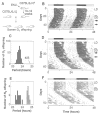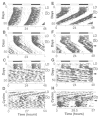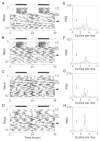Mutagenesis and mapping of a mouse gene, Clock, essential for circadian behavior
- PMID: 8171325
- PMCID: PMC3839659
- DOI: 10.1126/science.8171325
Mutagenesis and mapping of a mouse gene, Clock, essential for circadian behavior
Abstract
In a search for genes that regulate circadian rhythms in mammals, the progeny of mice treated with N-ethyl-N-nitrosourea (ENU) were screened for circadian clock mutations. A semidominant mutation, Clock, that lengthens circadian period and abolishes persistence of rhythmicity was identified. Clock segregated as a single gene that mapped to the midportion of mouse chromosome 5, a region syntenic to human chromosome 4. The power of ENU mutagenesis combined with the ability to clone murine genes by map position provides a generally applicable approach to study complex behavior in mammals.
Figures




References
-
- Klein DC, Moore RY, Reppert SM, editors. Suprachiasmatic Nucleus: The Mind’s Clock. Oxford University Press; New York: 1991.
- Takahashi JS. Curr Opin Neurobiol. 1991;1:556. - PubMed
- Takahashi JS, Murakami N, Nikaido SS, Pratt BL, Robertson LM. Recent Prog Horm Res. 1989;45:279. - PubMed
- Turek FW. 1994;49:43. ibid. - PubMed
- Michel S, Geusz ME, Zaritsky JJ, Block GD. Science. 1993;259:239. - PubMed
Publication types
MeSH terms
Substances
Grants and funding
LinkOut - more resources
Full Text Sources
Other Literature Sources
Medical
Molecular Biology Databases

